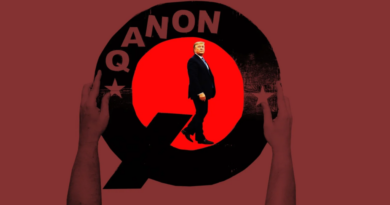QAnon Documentary ‘Q: Into the Storm’ Investigates Conspiracy-Theory Movement: TV Review

QAnon — the conspiracy-theory movement that sprung up on the far reaches of the internet — is a force with potentially long-lasting and transformational effects, having already placed untold numbers of Americans in its thrall and overtaken one of our two major political parties. It’s also deeply in line with this nation’s traditions of mutual mistrust of authority and our countrymen, and the American passion for pursuing novelty at the expense of logic. Perhaps only America could have created a force like QAnon; the question all of us must grapple with in the years to come is what kind of America QAnon will create.
This is a question “Q: Into the Storm,” a new six-part documentary set to air on HBO, does not meaningfully set out to answer. Director Cullen Hoback, whose films include 2018’s “What Lies Upstream,” set out on the project, set out three years ago to uncover the identity of “Q,” the anonymous purported figure whose cryptic pronouncements online have led many to believe that Donald Trump has been secretly fighting back against an army of pedophiles, that the former President was the one guard against the unchecked evil of the rest of the establishment. Perhaps predictably, given the tendency of conspiracy thinking to reproduce itself, Hoback seems to have lost a sense of proportion and of relative interest in his time in the rabbit hole. The overlong series he now releases nods at the cost the reproducibility of falsehoods online will force us all to bear. But it is most successful in its early going at thoughtlessly disseminating the Q message, and by its end has become a muddle with genuine bits of intriguing reporting studded amid so much dross.
A lot of what “Into the Storm” does poorly raises certain existential questions about how, and perhaps whether, to cover misinformation campaigns. Hoback’s film follows various figures within the QAnon universe — including Fredrick Brennan, the software developer who created and later repudiated the board 8chan where Q appeared, and key 8chan figures Jim and Ron Watkins, a father-son pair deeply tied into theories about Q’s true identity. Over the course of the time Hoback spends with these figures and others, he comes to develop his own theories about the identity of Q, which the documentary treats as a reveal and which it would be perhaps unsporting to reveal, even as backloading the fruits of reporting for maximum entertainment is a queasy tactic that does more to scandalize than to inform. (Not writing about Hoback’s theories makes it hard to write about how he pursues them, but the word “jaunty” often came to mind — a poor fit for the subject.) As he shares his findings, Hoback also allows the Watkinses and other QAnon believers a great deal of space to share their point of view.
For instance, the messages, and display names, of certain online superspreaders of the QAnon message are shown at length in the first episode, with the seeming understanding that these individuals are self-evidently deluded. Unfortunately, this seems a great deal of trust to place in a 2021 audience! (Unless it’s the opposite, and Hoback believes we literally cannot understand the concept of misinformation without having it demonstrated at unbelievable length.) While QAnon adherents lack a sort of magical power to convince any passerby to join the cause, they’ve been fairly successful at growing the movement through, among other mechanisms, a presence in the media. In one moment that flirts with parody, Hoback’s film plays, over and over, the QAnon catchphrase “where we go one, we go all,” before Hoback intones “Q understands that repetition is a useful psychological tactic when trying to mobilize people behind a common cause.” If Hoback gets it, too, then he’s playing things concerningly fast-and-loose, going for jazzy visual impact with the high cost of signal-boosting the very people wreaking madness on our nation.
To his credit, Hoback gets genuinely chilling footage of the sort of people close to the center of QAnon, those who might seem to have had a hand in shaping it. To cite just a single example, Brennan, a person of short stature who uses a wheelchair, faces down chilling threats of physical harm from his Q-world acquaintances that take the form of jokes about the gas chambers at Nazi concentration camps. (Brennan, in his renunciation of a world he helped build, is the series’ most moving figure — a person who might have been the focus of a less scattered work.)
But others come in for less considered treatment. The Watkinses, figures of serious consequence within this movement, also get every strange and unsocialized moment, not just the cruel ones, played, as if the series can’t decide how gravely to take the threat they pose. And interviews with various believers play as Coen-brothers-movie vignettes about oafs and clods. There’s a notable, unbecoming snappiness to the editing suddenly introducing the child of a couple who have committed themselves to the Q movement, in which one senses the comic sensibility of executive producer Adam McKay, even more out of place here than in “Vice.” And in one notable segment, a fellow named Craig, a YouTuber who covers QAnon topics, takes a meeting of his “sources,” including a self-described “Benghazi whistleblower.” “Yeah, we’re in it, we’re going to murder them all,” this YouTuber tells the camera, noting to the cameraman that “you even smirked at that.” He has a White Claw alco-pop in front of him, and repeatedly belches, interrupting the conversation. This resumes later, with Hoback telling us that conspiracy theories that ended up retweeted by Trump during the 2020 campaign originated with “the same dude feeding Craig scoops… in between burps.”
This all creates the impression, one that should absolutely not be the case, that the only way for the mainstream media apparatus to meaningfully take on Q adherents is to mock them along lines well beneath legitimate argument: Bodily grossness, uncouthness. It also has the effect of promoting Q thinkers (Craig’s last name and YouTube channel, which I am not publishing here, are shown onscreen in the documentary) while scoring cheap laughs off of them. One wonders if Craig will transcend the momentary embarrassment of onscreen gas-passing to have a grander last laugh.
This is hardly the only instance of placing a figure onscreen but exhibiting no real curiosity about them; another figure, a former newspaper journalist now obsessed with conspiracy thinking, gets plenty of airtime early on but gives us little in the way of insight into what, exactly, led to her snap away from reality. Maybe she wouldn’t respond to questioning, but given her placement in a series that views QAnon primarily as a rollicking mystery stocked with oddballs, the impression the viewer walks away with is that it was easier not to ask, to slot her into a picaresque story that, despite being about a seismic force in the life of this nation, manages too often to feel as if it’s about nothing at all.
What “Q: Into the Storm” is trying to say is perpetually unclear; the mission to unmask Q, specifically, leaves much on the table as regards analysis of what Q’s writings have given the rest of us. The series identifies, for instance, 8chan as the ferment from which emerged the Christchurch, New Zealand mosque shootings in 2019, but then notes that the shooter in that case was likelier radicalized by the algorithms of Facebook and YouTube. Fair enough, but if the larger point here is that the entire internet is toxic, why are we spending six hours in the company of various 8chan personages? Brennan’s observation that 8chan, the origin of Q, evinces all the flaws of the broader internet is well-taken, but gives us nothing about why people in the late 2010s and early 2020s have been so precarious, so tenuously holding onto reality, that this specific unreality, more than any other on offer, felt more appealing.
This is hardly a call to cover QAnon members sympathetically. Among the best journalism I’ve read in the past year was a clear-eyed and troubling report on this movement by the writer Simon van Zuylen-Wood, published during the 2020 election season that saw the elevation of conspiracy theorist Marjorie Taylor Greene. It treated QAnon beliefs as malevolently wrongheaded and the province of gullibles and marks, but it also sought to explain what about those beliefs is appealing beyond that they’re repeated a lot and that they appeal to the sort of people who burp on camera. But not every journalist is as skillful as van Zuylen-Wood, nor is every format as well-suited to convey troubling information as the magazine story that can be read in a sitting. A baggy six-hour series that seeks to keep the audience on its hook ends up finding within QAnon a story that, for good or ill, is defining our lives going forward; that’s the easy part, and, so deep within the matrix that he cannot consistently see what details are most important, Hoback almost bobbles that. “Q: Into the Storm” also labors to convince us that QAnon is an affectedly amusing tale. That much, for all this film strains, never feels like anything more than misinformation.


